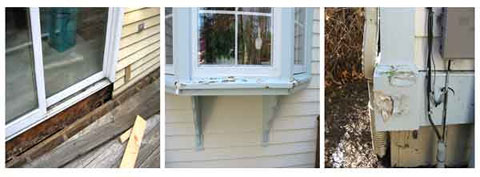Wood rot problems occur more frequently outdoors where water puddles on wood features like window sills. Wood rot also occurs when water is absorbed by wood like the plywood sheathing behind your siding, and can’t dry out because there isn’t enough ventilation.
The most common form of wood rot is wet rot where decay happens in areas where lumber has become and remains wet. Dry rot is caused by specific fungi and it’s more serious because it is spread by spores, seemingly without moisture although we know that’s still required. Both types of wood rot if not addressed, will cause structural damage to your house.
How to Avoid Wood Rot
Houses are built from wood and that isn’t going to change quickly, although metal framing and new technologies like Insulating Concrete Forms (ICFs) for foundations and framing are entering the market. Homeowners need to focus on minimizing moisture buildup around and inside their homes.
Simple things like trimming foundation plantings for air flow around your foundation and thinning out trees will help keep your home dry. Installing gutters and making sure the land slopes away from your home will help prevent water leaking into your house. Indoors you’ll want to inspect around water features (sinks, dishwasher, washing machine, toilets and tubs/showers) for leaks that could cause wood rot.
When repairing wood rot, consider using composite materials like Azek instead of wood. Remember that wood rot only happens where there’s a food source (wood) and moisture.
Most Common Wood Rot Problems
Here are the top 12 wood rot problems homeowners have to deal with, starting at your roof line. By inspecting these areas of your home annually and making repairs quickly, you’ll minimize your maintenance costs and protect your home.

- Wood right below the roof line
- Behind gutters and downspouts
- Wood trim that sticks out from the house
- Wood above and around doors and windows
- Window sills are especially prone to wood rot
- At the bottom of exterior doors
- Kick plates or vertical boards right below exterior doors
- Garage door and surrounding wood trim/siding
- Deck ledger board where it attaches to the house
- Deck floor boards when water can’t drain through to ground
- Deck posts where they meet the ground
- Top of foundation if foundation plantings don’t let wood dry out
